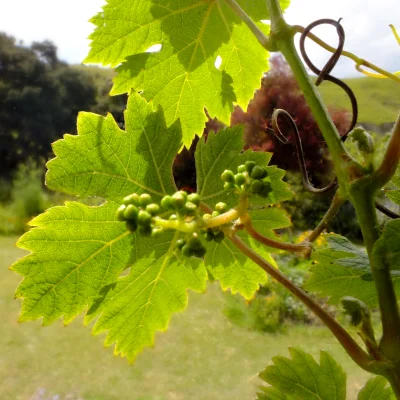Dessert Grape (Vitis vinifera)
Dessert grapes are cultivars of Vitis vinifera grown for their sweet, juicy berries, commonly eaten fresh. Popular varieties include Thompson Seedless, Muscat, and Crimson Seedless. These vines are adaptable and thrive in sunny, temperate regions, making them well-suited for southern hemisphere climates.
Description
- Growth Habit: Deciduous, climbing vine with tendrils.
- Leaves: Broad, lobed, and deeply veined.
- Flowers: Small, greenish, and fragrant; appear in late spring (October to November).
- Fruit: Clusters of sweet, thin-skinned berries ripen in summer (January to March).
- Lifespan: Long-lived, producing fruit for decades with proper care.
Propagation
Grapevines are propagated by cuttings, layering, or grafting.
-
By Cuttings (Most Common):
- Take hardwood cuttings (30-40 cm) in winter (June to August).
- Ensure cuttings have at least three nodes.
- Plant in well-draining soil, burying two nodes below the surface, and keep moist.
-
By Layering:
- In spring (September to November), bury a portion of a low vine in soil, leaving the tip exposed.
- Once rooted (after a few months), sever and transplant.
-
By Grafting:
- Grafting is used to combine a hardy rootstock with a desired fruiting variety. Best performed in late winter (July).
Cultivation
Dessert grapes thrive in sunny, well-drained locations.
-
Climate:
- Prefer warm, dry summers and mild winters.
- Frost-sensitive during budding in early spring (September).
-
Soil:
- Require well-draining, sandy loam soil with a pH of 6.0-7.5.
-
Planting:
- Space plants 2-3 meters apart along a trellis or arbor.
- Dig a hole twice the size of the root ball, ensuring roots are spread out.
-
Watering:
- Water deeply but infrequently. Allow the soil to dry slightly between waterings.
- Reduce watering as fruit ripens to concentrate sugars.
-
Fertilizing:
- Apply a balanced fertilizer (e.g., 10-10-10 NPK) in early spring (August).
- Supplement with potassium in late spring (October) for better fruiting.
-
Pruning:
- Prune in winter (July) to shape and remove old wood, encouraging new fruit-bearing canes.
- Thin fruit clusters in spring (October) to improve berry size and quality.
-
Pests/Diseases:
- Monitor for powdery mildew, downy mildew, and aphids.
- Treat organically with sulfur or neem oil as needed.
Uses and Benefits
- Culinary:
- Eaten fresh or used in fruit salads, desserts, and drinks.
- Can be dried to make raisins or pressed for juice.
- Nutritional Value:
- High in vitamins C and K, antioxidants, and natural sugars.
- Shade and Aesthetics:
- Provides excellent shade when grown on a pergola or arbor.
- Adds beauty to the landscape with lush leaves and hanging fruit clusters.
- Biodiversity:
- Flowers attract pollinators such as bees and wasps.
- Economic Value:
- A productive vine can yield several kilograms of fruit annually.
Grapes in a Forest Garden
Dessert grapes integrate well into a forest garden as climbers in the vertical layer.
- Role in Layers:
- Grown on trellises, fences, or trees to utilize vertical space without shading ground-layer crops.
- Companionship:
- Plant with nitrogen-fixing species (e.g., acacias or peas) to enrich the soil.
- Compatible with herbs like lavender or thyme, which deter pests and improve air circulation.
- Soil Improvement:
- Mulch beneath vines with organic matter to retain moisture and build soil fertility.
- Seasonal Interest:
- Offers fruit in summer (January to March) and vibrant autumn foliage.
Considerations
To prevent the vine from becoming invasive or shading out other plants, maintain regular pruning and train it onto a well-defined structure. With its ability to provide food, shade, and beauty, dessert grapes are a multifunctional and rewarding addition to a diverse forest garden system.
